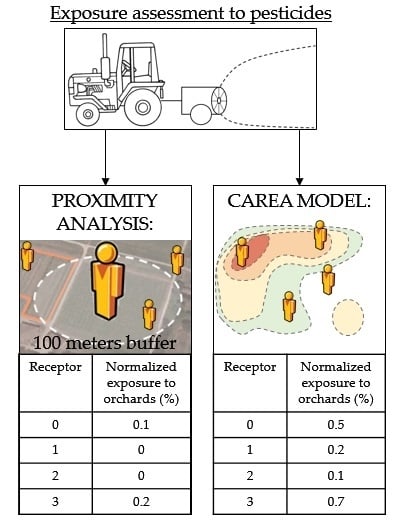Atmospheric Dispersion Modelling and Spatial Analysis to Evaluate Population Exposure to Pesticides from Farming Processes
Abstract
1. Introduction
2. Experiments
2.1. Geographical Context and Dataset
2.2. Proximity Model
2.3. Atmospheric Dispersion by CAREA
2.4. On-Site Measurement Campaign
2.5. CAREA Simulation on the Test Site
3. Results and Discussion
3.1. Comparison between the Proximity Model and the CAREA Model
3.2. CAREA Simulation on the Test Site
3.3. On-Site Measurement Campaign
4. Conclusions
Acknowledgments
Author Contributions
Conflicts of Interest
References
- Townson, H. Public health impact of pesticides used in agriculture. Trans. R. Soc. Trop. Med. Hyg. 1992, 86, 350. [Google Scholar] [CrossRef]
- Gil, Y.; Sinfort, C. Emission of pesticides to the air during sprayer application: A bibliographic review. Atmos. Environ. 2005, 39, 5183–5193. [Google Scholar] [CrossRef]
- Margni, M.; Rossier, D.; Crettaz, P.; Jolliet, O. Life cycle impact assessment of pesticides on human health and ecosystems. Agric. Ecosyst. Environ. 2002, 93, 379–392. [Google Scholar] [CrossRef]
- Damalas, C.A.; Eleftherohorinos, I.G. Pesticide exposure, safety issues, and risk assessment indicators. Int. J. Environ. Res. Public Health 2011, 8, 1402–1419. [Google Scholar] [CrossRef] [PubMed]
- Van Der Werf, H.M.G. Assessing the impact of pesticides on the environment. Agric. Ecosyst. Environ. 1996, 60, 81–96. [Google Scholar] [CrossRef]
- Levitan, L.; Merwin, I.; Kovach, J. Assessing the relative environmental impacts of agricultural pesticides: The quest for a holistic method. Agric. Ecosyst. Environ. 1995, 55, 153–168. [Google Scholar] [CrossRef]
- Zauli Sajani, S.; Forti, S.; Lauriola, P. Benzene exposure in Modena: Historical trend and health risk assessment. Epidemiol. Prev. 2005, 29, 13–18. [Google Scholar] [PubMed]
- Mattison, D.R.; Sandler, J.D. Summary of the workshop on issues in risk assessment: Quantitative methods for developmental toxicology. Risk Anal. 1994, 14, 595–604. [Google Scholar] [CrossRef] [PubMed]
- Agenzia per la Protezione, dell’Ambiente e per i Servizi Tecnici (Apat). Criteri Metodologici per L’applicazione Dell’analisi Assoluta di Rischio ai siti Contaminati. Rome, 2008. Available online: https://www.google.com.sg/url?sa=t&rct=j&q=&esrc=s&source=web&cd=2&ved=0ahUKEwj5zfyuwu_YAhXDNpQKHZTqDIsQFgguMAE&url=http%3A%2F%2Fwww.isprambiente.gov.it%2Ffiles%2Ftemi%2Fsiti-contaminati-02marzo08.pdf&usg=AOvVaw3U7EIHq1t_yKh_B4u5vIVt (accessed on 23 January 2018).
- Samet, J.M.; Schnatter, R.; Gibb, H. Invited commentary: Epidemiology and risk assessment. Am. J. Epidemiol. 1998, 148, 929–936. [Google Scholar] [CrossRef] [PubMed]
- Goodchild, M.F. Geographic information systems and science: Today and tomorrow. Procedia Earth Planet. Sci. 2009, 1, 1037–1043. [Google Scholar] [CrossRef]
- Auchincloss, A.H.; Gebreab, S.Y.; Mair, C.; Diez Roux, A.V. A Review of Spatial Methods in Epidemiology, 2000–2010. Annu. Rev. Public Health 2012, 33, 107–122. [Google Scholar] [CrossRef] [PubMed]
- Jacquez, G.M. Spatial analysis in epidemiology: Nascent science or a failure of GIS? J. Geogr. Syst. 2000, 2, 91–97. [Google Scholar] [CrossRef]
- Nuckols, J.R.; Ward, M.H.; Jarup, L. Using geographic information systems for exposure assessment in environmental epidemiology studies. Environ. Health Perspect. 2004, 112, 1007–1015. [Google Scholar] [CrossRef] [PubMed]
- Malagoli, C.; Costanzini, S.; Heck, J.E.; Malavolti, M.; De Girolamo, G.; Oleari, P.; Palazzi, G.; Teggi, S.; Vinceti, M. Passive exposure to agricultural pesticides and risk of childhood leukemia in an Italian community. Int. J. Hyg. Environ. Health 2016, 219, 742–748. [Google Scholar] [CrossRef] [PubMed]
- Ranzi, A.; Cordioli, M. Metodi e approcci per l’analisi quantitativa. Ecoscenza 2014, 4, 98–99. [Google Scholar]
- Johnson, B.; Barry, T.; Wofford, P. Workbook for Gaussian Modeling Analysis of Air Concentration Measurements Workbook for Gaussian Modeling Analysis of Air Concentration Measurements; Environmental Protection Agency, Department of Pesticide Regulation Environmental, Monitoring Branch: Sacramento, CA, USA, 2010.
- Smith, R.J. A Gaussian model for estimating odour emissions from area sources. Math. Comput. Model. 1995, 21, 23–29. [Google Scholar] [CrossRef]
- Tsai, M.Y.; Elgethun, K.; Ramaprasad, J.; Yost, M.G.; Felsot, A.S.; Hebert, V.R.; Fenske, R.A. The Washington aerial spray drift study: Modeling pesticide spray drift deposition from an aerial application. Atmos. Environ. 2005, 39, 6194–6203. [Google Scholar] [CrossRef]
- Wittich, K.P.; Siebers, J. Aerial short-range dispersion of volatilized pesticides from an area source. Int. J. Biometeorol. 2002, 46, 126–135. [Google Scholar] [CrossRef] [PubMed]
- Ghermandi, G.; Teggi, S.; Fabbi, S.; Bigi, A.; Cecchi, R. Model comparison in simulating the atmospheric dispersion of a pollutant plume in low wind conditions. Int. J. Environ. Pollut. 2012, 48, 69. [Google Scholar] [CrossRef]
- Karamchandani, P.; Vijayaraghavan, K.; Yarwood, G. Sub-grid scale plume modeling. Atmosphere 2011, 2, 389–406. [Google Scholar] [CrossRef]
- Teske, M.E.; Bird, S.L.; Esterly, D.M.; Curbishley, T.B.; Ray, S.L.; Perry, S.G. AgDrift®: A model for estimating near-field spray drift from aerial applications. Environ. Toxicol. Chem. 2002, 21, 659–671. [Google Scholar] [CrossRef] [PubMed]
- Bilanin, A.J.; Teske, M.E.; Barry, J.W.; Ekblad, R.B. AGDISP: The Aircraft Spray Dispersion Model, Code Development and Experimental Validation. Trans. ASABE 1989, 32, 327–334. [Google Scholar] [CrossRef]
- Reiss, R.; Griffin, J. A probabilistic model for acute bystander exposure and risk assessment for soil fumigants. Atmos. Environ. 2006, 40, 3548–3560. [Google Scholar] [CrossRef]
- Teggi, S.; Costanzini, S.; Ghermandi, G.; Malagoli, C.; Vinceti, M. A GIS-based atmospheric dispersion model for pollutants emitted by complex source areas. Sci. Total Environ. 2018, 610–611, 175–190. [Google Scholar] [CrossRef] [PubMed]
- Cimorelli, A.J.; Perry, S.G.; Venkatram, A.; Weil, J.C.; Paine, R.J.; Wilson, R.B.; Lee, R.F.; Peters, W.D.; Brode, R.W.; Paumier, J.O. AERMOD: Description of Model Formulation; Report; Scholar’s Choice: London, ON, Canada, 2004; Volume 44, pp. 1–91. [Google Scholar]
- Python Software Foundation. Python Language Reference, Version 2.7; Python Software Foundation: Wilmington, DE, USA, 2013. [Google Scholar]
- Batiha, M.A.; Al-Makhadmeh, L.A.; Batiha, M.M.; Ramadan, A.; Kadhum, A.A.H. Generalization of the mafram methodology for semi-volatile organic agro-chemicals. Water. Air. Soil Pollut. 2014, 225. [Google Scholar] [CrossRef]
- Batiha, M.A.; Kadhum, A.A.H.; Batiha, M.M.; Takriff, M.S.; Mohamad, A.B. MAFRAM-A new fate and risk assessment methodology for non-volatile organic chemicals. J. Hazard. Mater. 2010, 181, 1080–1087. [Google Scholar] [CrossRef] [PubMed]
- Nimmatoori, P.; Kumar, A. Development and evaluation of a ground-level area source analytical dispersion model to predict particulate matter concentration for different particle sizes. J. Aerosol Sci. 2013, 66, 139–149. [Google Scholar] [CrossRef]
- Nimmatoori, P.; Kumar, A. Evaluation of area source models to predict near ground level concentrations due to emissions released during agricultural applications. J. Hazard. Mater. 2013, 246–247, 44–51. [Google Scholar] [CrossRef] [PubMed]
- Pivato, A.; Barausse, A.; Zecchinato, F.; Palmeri, L.; Raga, R.; Lavagnolo, M.C.; Cossu, R. An integrated model-based approach to the risk assessment of pesticide drift from vineyards. Atmos. Environ. 2015, 111, 136–150. [Google Scholar] [CrossRef]
- Van den Berg, F.; Jacobs, C.M.J.; Butler Ellis, M.C.; Spanoghe, P.; Doan Ngoc, K.; Fragkoulis, G. Modelling exposure of workers, residents and bystanders to vapour of plant protection products after application to crops. Sci. Total Environ. 2016, 573, 1010–1020. [Google Scholar] [CrossRef] [PubMed]
- Martinez, A.; Spak, S.N.; Petrich, N.T.; Hu, D.; Carmichael, G.R.; Hornbuckle, K.C. Atmospheric dispersion of PCB from a contaminated Lake Michigan harbor. Atmos. Environ. 2015, 122, 791–798. [Google Scholar] [CrossRef] [PubMed]
- Bauer, T.J. Comparison of chlorine and ammonia concentration field trial data with calculated results from a Gaussian atmospheric transport and dispersion model. J. Hazard. Mater. 2013, 254–255, 325–335. [Google Scholar] [CrossRef] [PubMed]
- Llanos, W.; Kocman, D.; Higueras, P.; Horvat, M. Mercury emission and dispersion models from soils contaminated by cinnabar mining and metallurgy. J. Environ. Monit. 2011, 13, 3460–3468. [Google Scholar] [CrossRef] [PubMed]
- Tartakovsky, D.; Stern, E.; Broday, D.M. Dispersion of TSP and PM10 emissions from quarries in complex terrain. Sci. Total Environ. 2016, 542, 946–954. [Google Scholar] [CrossRef] [PubMed]
- Tartakovsky, D.; Stern, E.; Broday, D.M. Indirect estimation of emission factors for phosphate surface mining using air dispersion modeling. Sci. Total Environ. 2016, 556, 179–188. [Google Scholar] [CrossRef] [PubMed]
- Brianza, M. Distribuzione dei Fitofarmaci: Stato Dell’ Arte e Impiego di Attrezzature Intelligenti per il Contenimento dei Costi e il Miglioramento Della Sostenibilità Delle Produzioni Vitivinicole Milanesi e Lombarde; Coldiretti: Monza Brianza, Italy, 2015; ISBN 978-88-9-407222-8. [Google Scholar]
- Hall, F.R.; Chapple, A.C.; Downer, R.A.; Kirchner, L.M.; Thacker, J.R.M. Pesticide application as affected by spray modifiers. J. Pestic. Sci. 1993, 38, 123–133. [Google Scholar] [CrossRef]
- Hilz, E.; Vermeer, A.W.P. Spray drift review: The extent to which a formulation can contribute to spray drift reduction. Crop Prot. 2013, 44, 75–83. [Google Scholar] [CrossRef]
- Bigi, A.; Ghermandi, G.; Harrison, R.M. Analysis of the air pollution climate at a background site in the Po valley. J. Environ. Monit. 2012, 14, 552–563. [Google Scholar] [CrossRef] [PubMed]
- Bocchiola, D.; Nana, E.; Soncini, A. Impact of climate change scenarios on crop yield and water footprint of maize in the Po valley of Italy. Agric. Water Manag. 2013, 116, 50–61. [Google Scholar] [CrossRef]
- Peel, M.C.; Finlayson, B.L.; McMahon, T.A. Updated world map of the Köppen-Geiger climate classification. Hydrol. Earth Syst. Sci. Discuss. 2007, 4, 439–473. [Google Scholar] [CrossRef]
- Rubel, F.; Kottek, M. Observed and projected climate shifts 1901–2100 depicted by world maps of the Köppen-Geiger climate classification. Meteorol. Z. 2010, 19, 135–141. [Google Scholar] [CrossRef]
- Vinceti, M.; Filippini, T.; Violi, F.; Rothman, K.J.; Costanzini, S.; Malagoli, C.; Wise, L.A.; Odone, A.; Signorelli, C.; Iacuzio, L.; et al. Pesticide exposure assessed through agricultural crop proximity and risk of amyotrophic lateral sclerosis. Environ. Health 2017, 16, 91. [Google Scholar] [CrossRef] [PubMed]
- Bossard, M.; Feranec, J.; Otahel, J. CORINE Land Cover Technical Guide—Addendum 2000; Technical Report; No. 105; European Eviroment Agency: Copenhagen, Denmark, 2000. [Google Scholar]
- Geoportale Della Regione Emilia Romagna. Available online: https://geoportale.regione.emilia-romagna.it/it (accessed on 12 October 2017).
- Ward, M.H.; Nuckols, J.R.; Giglierano, J.; Bonner, M.R.; Wolter, C.; Airola, M.; Mix, W.; Colt, J.S.; Hartge, P. Positional Accuracy of Two Methods of Geocoding. Epidemiology 2005, 16, 542–547. [Google Scholar] [CrossRef] [PubMed]
- Bonner, M.R.; Han, D.; Nie, J.; Rogerson, P.; Vena, J.E.; Freudenheim, J.L. Positional accuracy of geocoded addresses in epidemiologic research. Epidemiology 2003, 14, 408–412. [Google Scholar] [CrossRef] [PubMed]
- Bell, E.M.; Hertz-Picciotto, I.; Beaumont, J.J. A case-control study of pesticides and fetal death due to congenital anomalies. Epidemiology 2001, 12, 148–156. [Google Scholar] [CrossRef] [PubMed]
- Comba, P.; Ascoli, V.; Belli, S.; Benedetti, M.; Gatti, L.; Ricci, P.; Tieghi, A. Risk of soft tissue sarcomas and residence in the neighbourhood of an incinerator of industrial wastes. Occup. Environ. Med. 2003, 60, 680–683. [Google Scholar] [CrossRef] [PubMed]
- Xiang, H.; Nuckols, J.R.; Stallones, L. A geographic information assessment of birth weight and crop production patterns around mother’s residence. Environ. Res. 2000, 82, 160–167. [Google Scholar] [CrossRef] [PubMed]
- Gunier, R.B.; Ward, M.H.; Airola, M.; Bell, E.M.; Colt, J.; Nishioka, M.; Buffler, P.A.; Reynolds, P.; Rull, R.P.; Hertz, A.; et al. Determinants of agricultural pesticide concentrations in carpet dust. Environ. Health Perspect. 2011, 119, 970–976. [Google Scholar] [CrossRef] [PubMed]
- Nuckols, J.R.; Gunier, R.B.; Riggs, P.; Miller, R.; Reynolds, P.; Ward, M.H. Linkage of the California Pesticide Use Reporting Database with spatial land use data for exposure assessment. Environ. Health Perspect. 2007, 115, 684–689. [Google Scholar] [CrossRef] [PubMed]
- Thatcher, T.L.; Layton, D.W. Deposition, resuspension, and penetration of particles within a residence. Atmos. Environ. 1995, 29, 1487–1497. [Google Scholar] [CrossRef]
- ARPA Regional Agency for Environmental Protection and Prevention in the Emilia-Romagna Region, I. LAMA. Available online: https://www.arpae.it/cms3/documenti/_cerca_doc/meteo/ambiente/descrizione_lama.pdf (accessed on 2 January 2018).
- Rockel, B.; Will, A.; Hense, A. The Regional Climate Model COSMO-CLM. Meteorol. Z. 2008, 17, 347–348. [Google Scholar] [CrossRef]
- Lombroso, L.; Quattrocchi, S. L’osservatorio di MODENA: 180 Anni di Misure Meteoclimatiche; Societa Meteorologica Subalpina: Moncalieri, Italy, 2008; ISBN 978-88-9-030232-9. [Google Scholar]
- Lombroso, L.; Teggi, S. Annuario delle osservazioni meteoclimatiche dell’anno 2014 all’Osservatorio Geofisico di Modena. Società dei Naturalisti e Matematici di Modena 2015, 146, 25–36. [Google Scholar]
- Bekiashev, K.A.; Serebriakov, V.V. World Meteorological Organization (WMO). In International Marine Organizations; Springer: Berlin/Heidelberg, Germany, 1981; pp. 540–552. [Google Scholar]
- Zhu, J.; He, Y.; Gao, M.; Zhou, W.; Hu, J.; Shen, J.; Zhu, Y.C. Photodegradation of emamectin benzoate and its influence on efficacy against the rice stem borer, Chilo suppressalis. Crop Prot. 2011, 30, 1356–1362. [Google Scholar] [CrossRef]
- Ishaaya, I.; Kontsedalov, S.; Horowitz, A.R. Emamectin, a novel insecticide for controlling field crop pests. Pest Manag. Sci. 2002, 58, 1091–1095. [Google Scholar] [CrossRef] [PubMed]
- Jansson, R.K.; Peterson, R.F.; Halliday, W.R.; Mookerjee, P.K.; Dybas, R.A. Efficacy of solid formulations of emamectin benzoate at controlling lepidopterous pests. Fla. Entomol. 1996, 79, 434–449. [Google Scholar] [CrossRef]
- Jansson, R.K.; Brown, R.; Cartwright, B.; Cox, D.; Dunbar, D.M.; Dybas, R.A.; Eckel, C.; Lasota, J.A.; Mookerjee, P.K.; Norton, J.A.; et al. Emamectin benzoate: A novel avermectin derivative for control of lepidopterous pests. In Proceedings of the 3rd International Workshop Management of Diamondback Moth Other Crucifer Pests, Kuala Lumpur, Malaysia, 29 October–1 November 1997; pp. 172–177. [Google Scholar]
- EPA Chemical Hazard Classification and Labeling: Comparison of Requirements and the GHS. Available online: https://www.epa.gov/sites/production/files/2015-09/documents/ghscriteria-summary.pdf (accessed on 9 January 2018).
- König, J.; Funcke, W.; Balfanz, E.; Grosch, B.; Pott, F. Testing a high volume air sampler for quantitative collection of polycyclic aromatic hydrocarbons. Atmos. Environ. 1980, 14, 609–613. [Google Scholar] [CrossRef]
- Bidleman, T.F.; Olney, C.E. High-volume collection of atmospheric polychlorinated biphenyls. Bull. Environ. Contam. Toxicol. 1974, 11, 442–450. [Google Scholar] [CrossRef] [PubMed]
- Hayward, S.J.; Gouin, T.; Wania, F. Comparison of Four Active and Passive Sampling Techniques for Pesticides in Air. Environ. Sci. Technol. 2010, 44, 3410–3416. [Google Scholar] [CrossRef] [PubMed]
- Scheyer, A.; Morville, S.; Mirabel, P.; Millet, M. Variability of atmospheric pesticide concentrations between urban and rural areas during intensive pesticide application. Atmos. Environ. 2007, 41, 3604–3618. [Google Scholar] [CrossRef]
- Coscollà, C.; Hart, E.; Pastor, A.; Yusà, V. LC-MS characterization of contemporary pesticides in PM10 of Valencia Region, Spain. Atmos. Environ. 2013, 77, 394–403. [Google Scholar] [CrossRef]
- Aulagnier, F.; Poissant, L.; Brunet, D.; Beauvais, C.; Pilote, M.; Deblois, C.; Dassylva, N. Pesticides measured in air and precipitation in the Yamaska Basin (Québec): Occurrence and concentrations in 2004. Sci. Total Environ. 2008, 394, 338–348. [Google Scholar] [CrossRef] [PubMed]
- Hart, K.M.; Pankow, J.F. High-Volume Air Sampler for Particle and Gas Sampling. 2. Use of Backup Filters To Correct for the Adsorption of Gas-Phase Polycyclic Aromatic Hydrocarbons to the Front Filter. Environ. Sci. Technol. 1994, 28, 655–661. [Google Scholar] [CrossRef] [PubMed]
- Cessna, A.J.; Waite, D.T.; Bailey, J.; Kerr, L.A.; Quiring, D.V. Desorption of herbicides from atmospheric particulates during high-volume air sampling. Atmosphere 2011, 2, 671–687. [Google Scholar] [CrossRef]
- Belmonte Vega, A.; Garrido Frenich, A.; Martínez Vidal, J.L. Monitoring of pesticides in agricultural water and soil samples from Andalusia by liquid chromatography coupled to mass spectrometry. Anal. Chim. Acta 2005, 538, 117–127. [Google Scholar] [CrossRef]
- Trevisan, M.; Montepiani, C.; Ragozza, L.; Bartoletti, C.; Ioannilli, E.; Del Re, A.A.M. Pesticides in rainfall and air in Italy. Environ. Pollut. 1993, 80, 31–39. [Google Scholar] [CrossRef]
- Haraguchi, K.; Kitamura, E.; Yamashita, T.; Kido, A. Simultaneous determination of trace pesticides in urban air. Atmos. Environ. 1994, 28, 1319–1325. [Google Scholar] [CrossRef]
- Borras, E.; Sanchez, P.; Munoz, A.; Tortajada-Genaro, L.A. Development of a gas chromatography-mass spectrometry method for the determination of pesticides in gaseous and particulate phases in the atmosphere. Anal. Chim. Acta 2011, 699, 57–65. [Google Scholar] [CrossRef] [PubMed]
- Liu, Z.; Berg, D.; Berg, D.; Schauer, J.; Tsai, C.-W.; Chang, C.-T.; Chiou, C.-S.; Shie, J.-L.; Chang, C.-T.; Chiou, C.-S.; et al. Sensitivity of Two Dispersion Models (AERMOD and ISCST3) to Input Parameters for a Rural Ground-Level Area Source. J. Air Waste Manag. Assoc. 2008, 58, 1288–1296. [Google Scholar] [CrossRef]
- Jeong, S.J. CALPUFF and AERMOD dispersion models for estimating odor emissions from industrial complex area sources. Asian J. Atmos. Environ. 2011, 5, 1–7. [Google Scholar] [CrossRef]
- Oliver, M.A.; Webster, R. Kriging: A method of interpolation for geographical information systems. Int. J. Geogr. Inf. Syst. 1990, 4, 313–332. [Google Scholar] [CrossRef]
- Schummer, C.; Mothiron, E.; Appenzeller, B.M.R.; Wennig, R.; Millet, M. Gas/particle partitioning of currently used pesticides in the atmosphere of Strasbourg (France). Air Qual. Atmos. Health 2010, 3, 171–181. [Google Scholar] [CrossRef]
- Yusà, V.; Coscollà, C.; Mellouki, W.; Pastor, A.; de la Guardia, M. Sampling and analysis of pesticides in ambient air. J. Chromatogr. A 2009, 1216, 2972–2983. [Google Scholar] [CrossRef] [PubMed]
- Coscollà, C.; Yahyaoui, A.; Colin, P.; Robin, C.; Martinon, L.; Val, S.; Baeza-Squiban, A.; Mellouki, A.; Yusà, V. Particle size distributions of currently used pesticides in a rural atmosphere of France. Atmos. Environ. 2013, 81, 32–38. [Google Scholar] [CrossRef]
- Coscollà, C.; Colin, P.; Yahyaoui, A.; Petrique, O.; Yusà, V.; Mellouki, A.; Pastor, A. Occurrence of currently used pesticides in ambient air of Centre Region (France). Atmos. Environ. 2010, 44, 3915–3925. [Google Scholar] [CrossRef]
- Yusà, V.; Coscollà, C.; Millet, M. New screening approach for risk assessment of pesticides in ambient air. Atmos. Environ. 2014, 96, 322–330. [Google Scholar] [CrossRef]
- Raeppel, C.; Fabritius, M.; Nief, M.; Appenzeller, B.M.R.; Millet, M. Coupling ASE, sylilation and SPME-GC/MS for the analysis of current-used pesticides in atmosphere. Talanta 2014, 121, 24–29. [Google Scholar] [CrossRef] [PubMed]
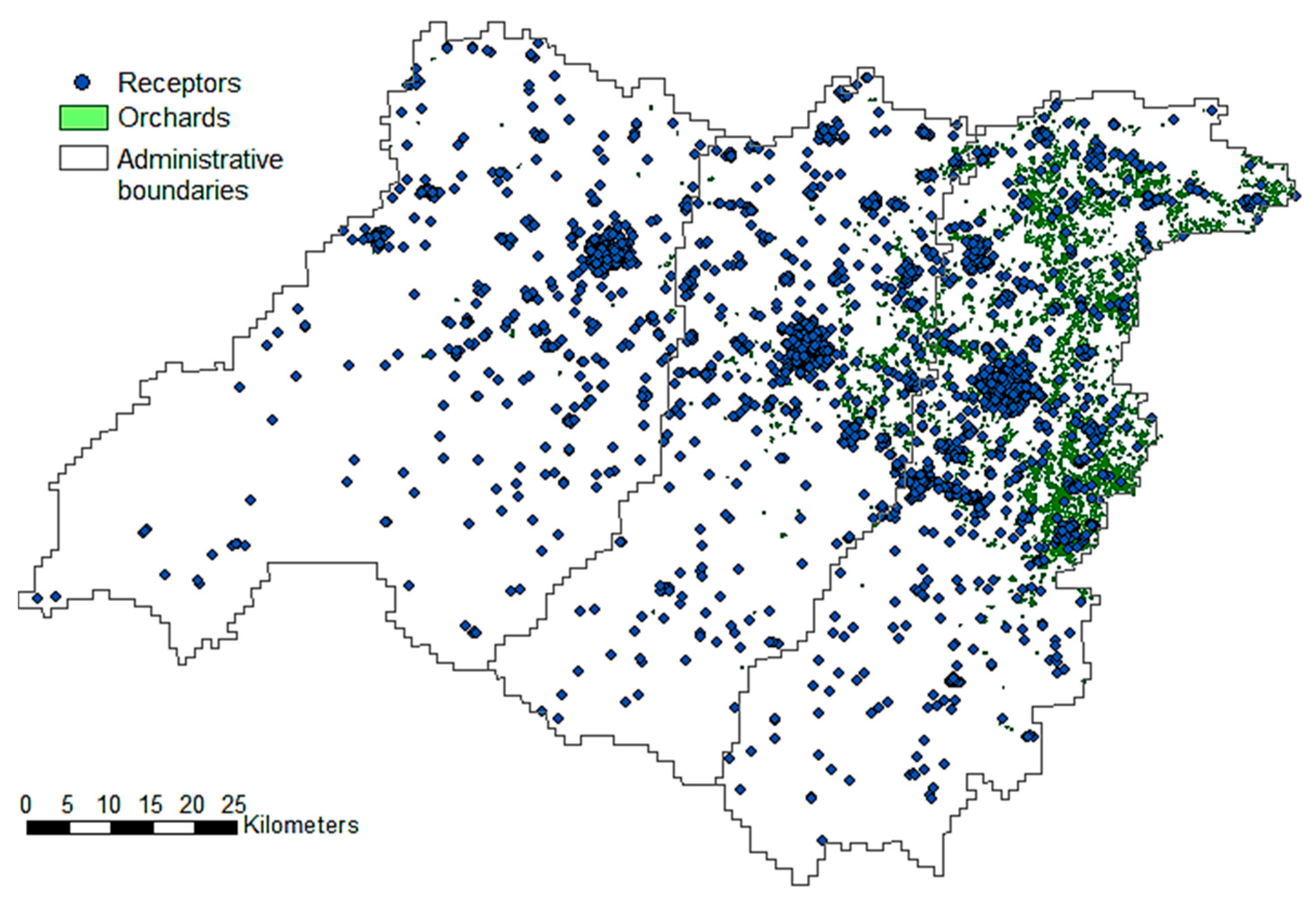
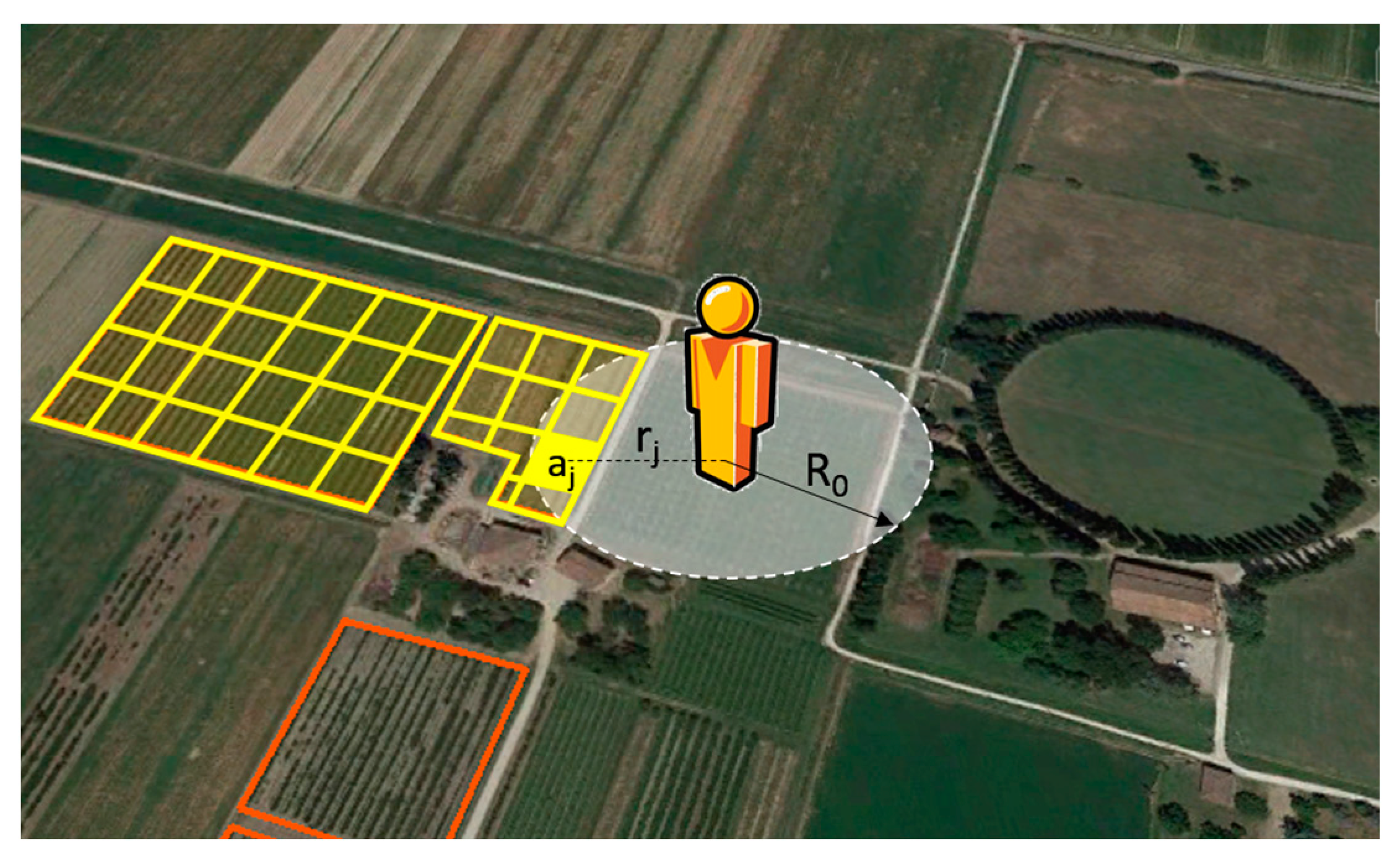
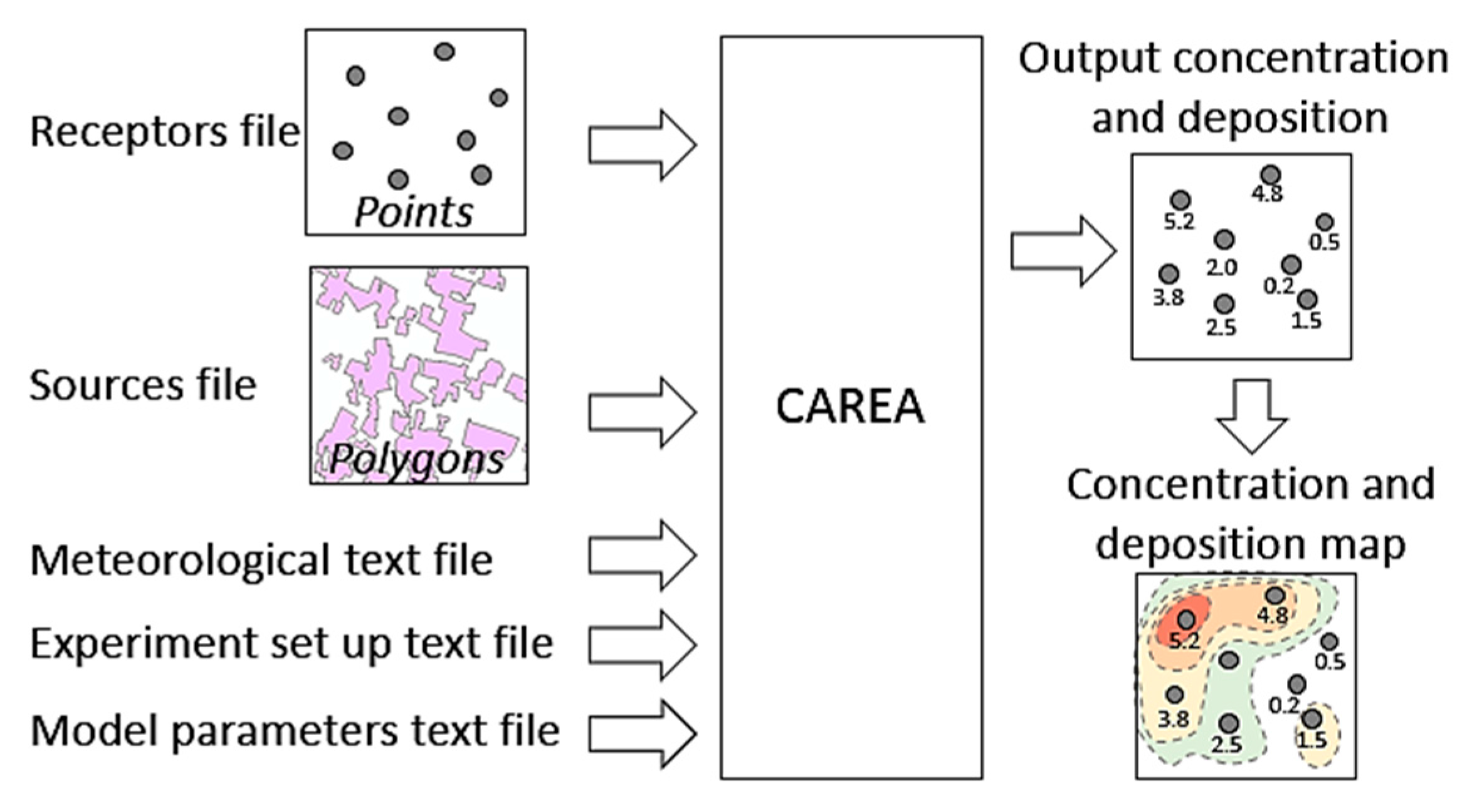
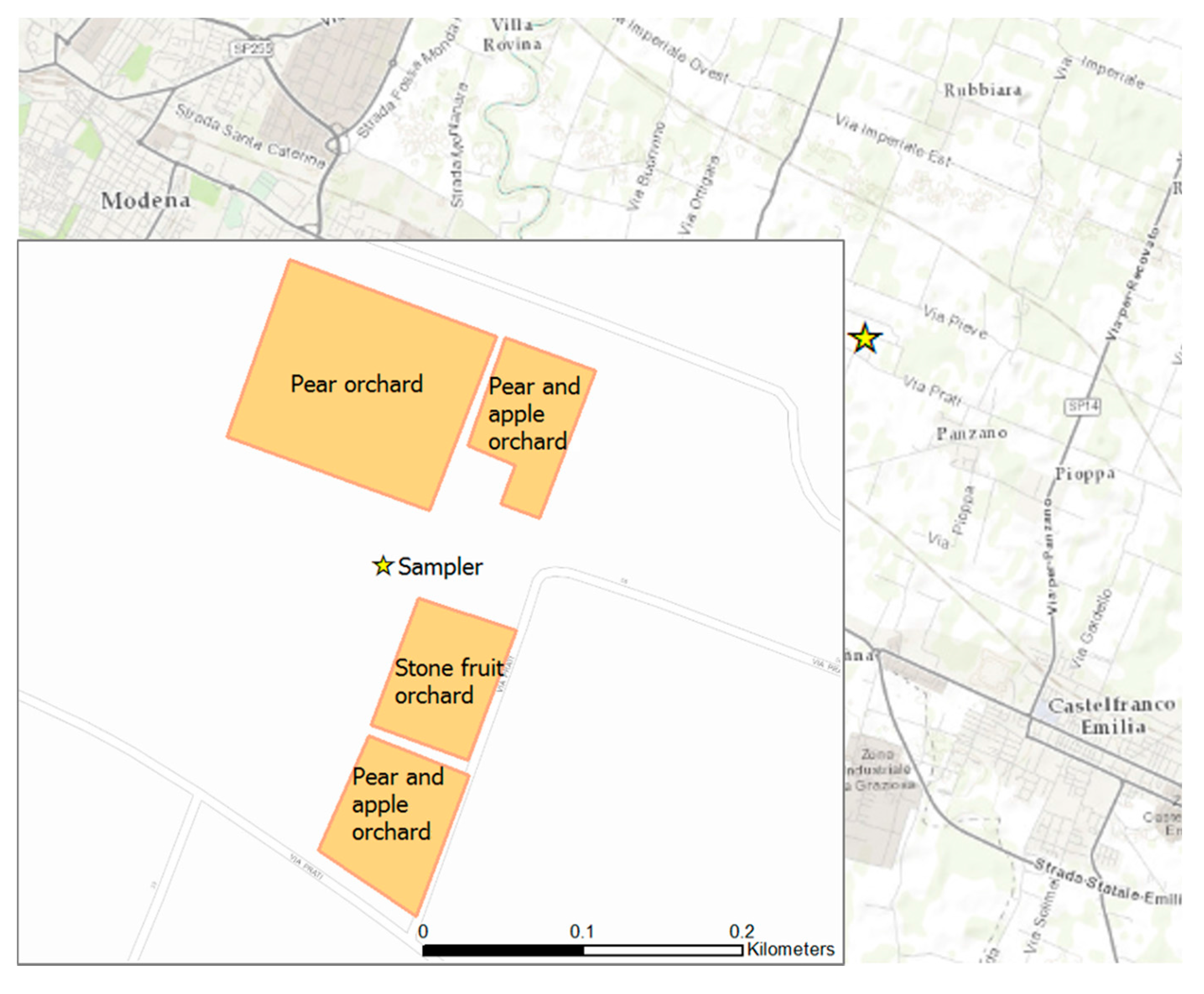
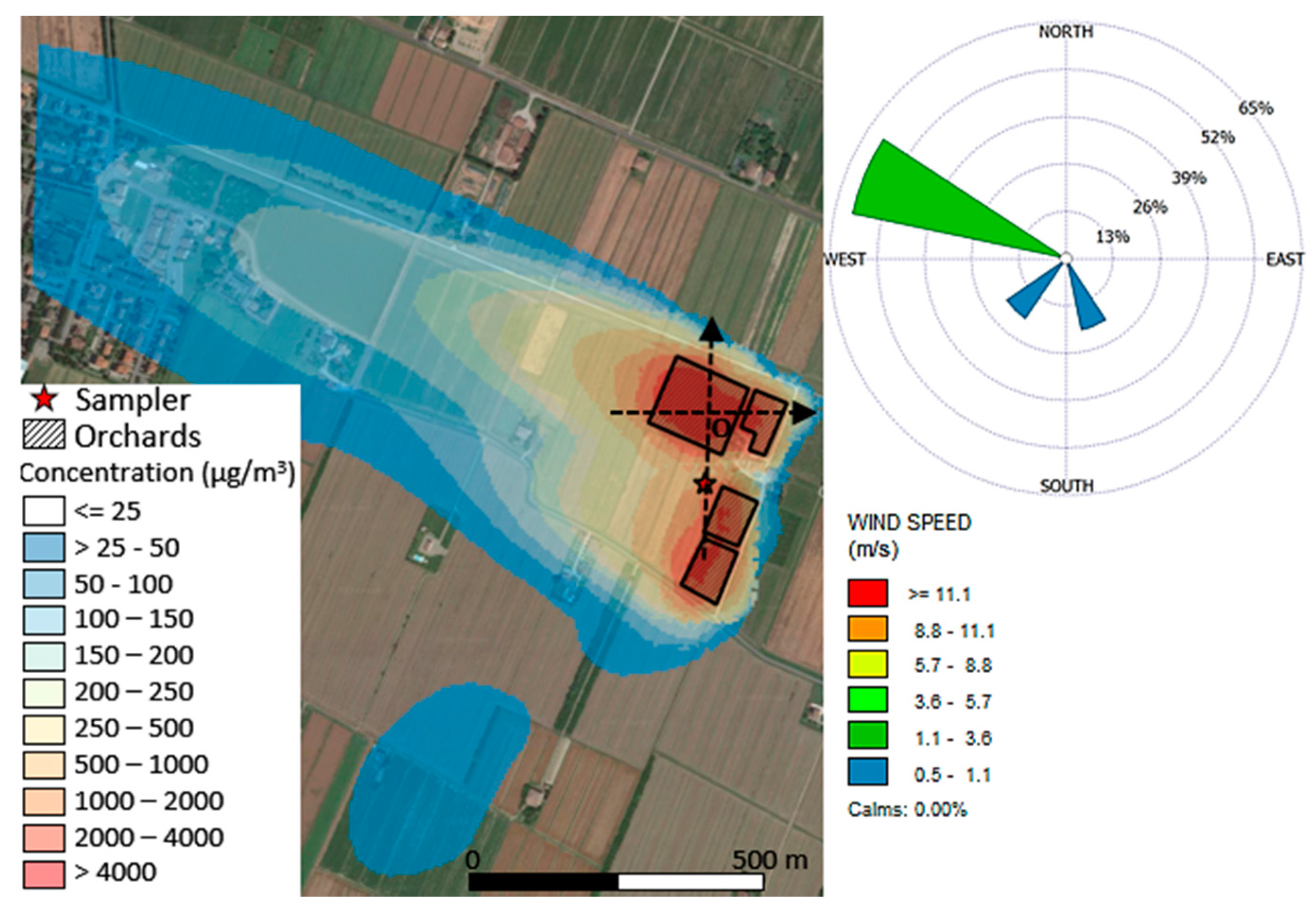
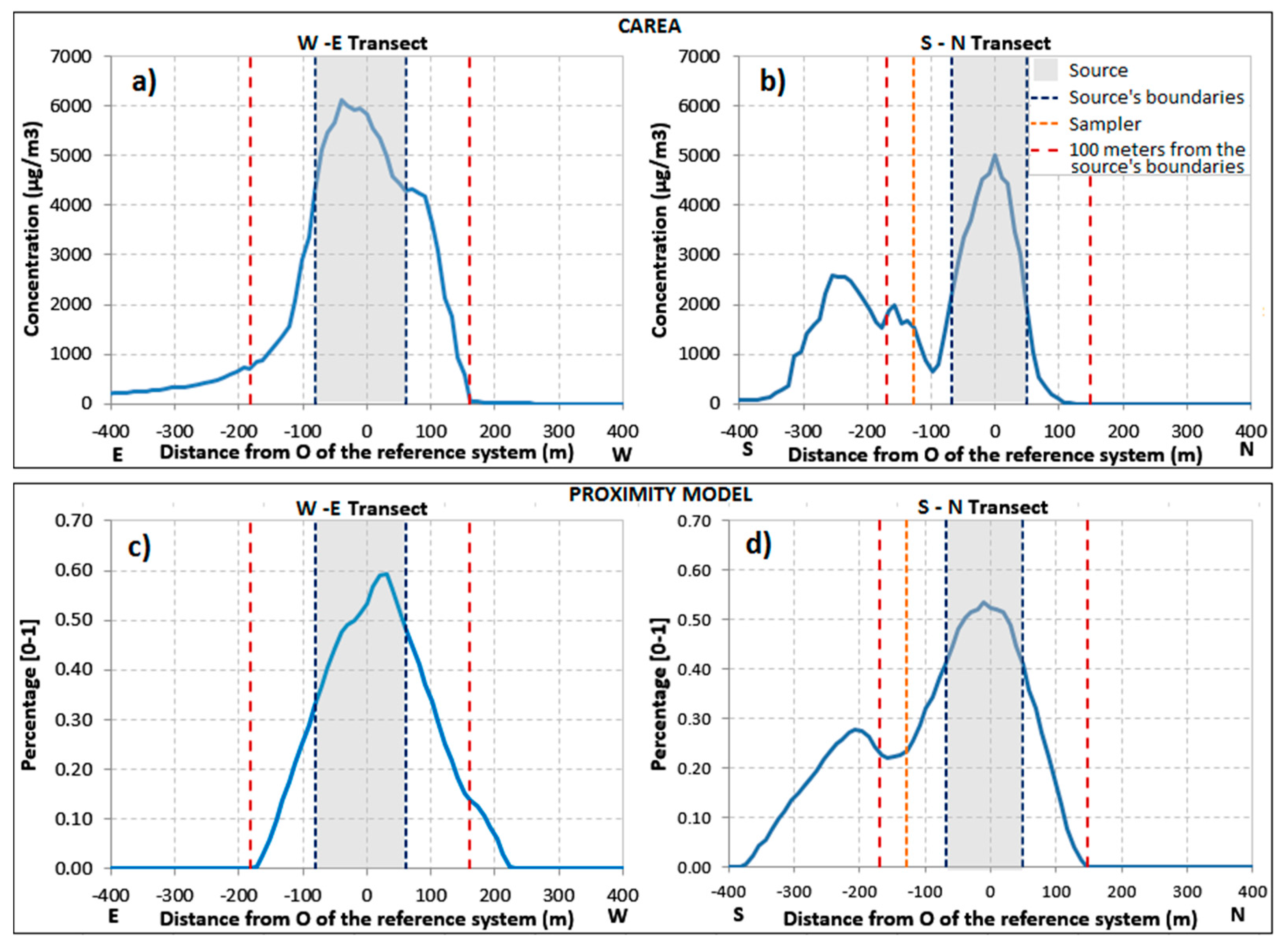
| Code | Proximity Analysis | CAREA | ||
|---|---|---|---|---|
| Number | % of Area | Number | Ĉ = C/C0 | |
| −999 | 2469 | 96 | 1181 | 46 |
| 0 | 73 | 3 | 1233 | 48 |
| 1 | 25 | 1 | 153 | 6 |
| 2 | 12 | 0 | 10 | 0 |
| 3 | 5 | 0 | 7 | 0 |
| Sum | 2584 | 100 | 2584 | 100 |
© 2018 by the authors. Licensee MDPI, Basel, Switzerland. This article is an open access article distributed under the terms and conditions of the Creative Commons Attribution (CC BY) license (http://creativecommons.org/licenses/by/4.0/).
Share and Cite
Costanzini, S.; Teggi, S.; Bigi, A.; Ghermandi, G.; Filippini, T.; Malagoli, C.; Nannini, R.; Vinceti, M. Atmospheric Dispersion Modelling and Spatial Analysis to Evaluate Population Exposure to Pesticides from Farming Processes. Atmosphere 2018, 9, 38. https://doi.org/10.3390/atmos9020038
Costanzini S, Teggi S, Bigi A, Ghermandi G, Filippini T, Malagoli C, Nannini R, Vinceti M. Atmospheric Dispersion Modelling and Spatial Analysis to Evaluate Population Exposure to Pesticides from Farming Processes. Atmosphere. 2018; 9(2):38. https://doi.org/10.3390/atmos9020038
Chicago/Turabian StyleCostanzini, Sofia, Sergio Teggi, Alessandro Bigi, Grazia Ghermandi, Tommaso Filippini, Carlotta Malagoli, Roberta Nannini, and Marco Vinceti. 2018. "Atmospheric Dispersion Modelling and Spatial Analysis to Evaluate Population Exposure to Pesticides from Farming Processes" Atmosphere 9, no. 2: 38. https://doi.org/10.3390/atmos9020038
APA StyleCostanzini, S., Teggi, S., Bigi, A., Ghermandi, G., Filippini, T., Malagoli, C., Nannini, R., & Vinceti, M. (2018). Atmospheric Dispersion Modelling and Spatial Analysis to Evaluate Population Exposure to Pesticides from Farming Processes. Atmosphere, 9(2), 38. https://doi.org/10.3390/atmos9020038







